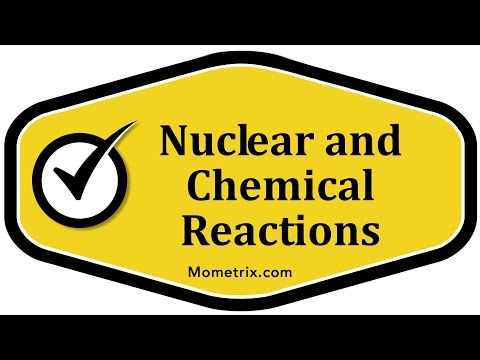Understanding the distinctions between chemical and nuclear reactions is pivotal for various fields, including chemistry, physics, and environmental science. While these types of reactions can lead to profound consequences in both natural phenomena and technological applications, they operate on disparate principles and yield markedly different results. This article delves into these differences, exploring their fundamental concepts, mechanisms, energy considerations, reaction rates, and real-world implications.
Basic Definitions
A chemical reaction is a process in which reactants are transformed into products through the rearrangement of atoms and the breaking and forming of chemical bonds. Chemical reactions typically involve the outermost electrons of atoms, influencing the structure and functionality of molecules. Conversely, a nuclear reaction involves changes in an atom’s nucleus, leading to the alteration of elemental identity, radioactive decay, or the release of vast amounts of energy through processes such as fission and fusion.
Types of Reactions
Chemical reactions can be broadly classified into categories, including synthesis (combination), decomposition, single displacement, and double displacement. Each type describes a unique way in which reactants interact. For example, in a synthesis reaction, two or more reactants combine to form a more complex product, whereas in decomposition, a compound breaks down into simpler substances.
Nuclear reactions, on the other hand, fall into several types, such as nuclear fission, nuclear fusion, radioactive decay, and neutron capture. Fission involves the splitting of a heavy nucleus into lighter nuclei, often accompanied by the release of neutrons and a substantial amount of energy. Fusion, the process that powers stars, entails the merging of lighter nuclei to form a heavier nucleus, also releasing energy. Radioactive decay processes—such as alpha, beta, and gamma decay—result in the transformation of unstable isotopes into more stable forms.
Energy Changes
The energy involved in chemical reactions can vary widely but is typically within the range of kilojoules per mole. Endothermic reactions absorb energy, while exothermic reactions release energy. Activation energy—the energy required to initiate a chemical reaction—plays a crucial role in determining reaction rates and pathways. Catalysts, substances that increase reaction rates without being consumed, can lower activation energy, significantly speeding up reactions.
Nuclear reactions, however, are characterized by their enormous energy output. The energy released during nuclear fission or fusion can be millions of times greater than that of chemical reactions, measured in millions of electron volts (MeV). This substantial energy release arises from the conversion of a small amount of mass into energy, as delineated by Einstein’s equation, E=mc². Consequently, nuclear reactions have profound implications for energy generation, as evidenced by nuclear power plants and thermonuclear weapons.
Mechanism of Reactions
The mechanisms underlying chemical reactions typically involve the formation and breaking of chemical bonds, guided by principles of valence and electron behavior. Factors such as temperature, concentration, pressure, and the presence of catalysts can significantly influence these reactions. The transition state theory describes the progress of a reaction as it moves through a series of intermediate states, eventually reaching a product configuration.
Nuclear reactions are fundamentally different, as they occur within the atomic nucleus and often involve nuclear forces that operate at extremely short ranges. The mechanisms of these reactions are influenced by properties such as neutron-to-proton ratios, binding energy, and the stability of isotopes. The strong nuclear force, which binds protons and neutrons together within the nucleus, plays a central role in nuclear stability and reaction pathways. This interaction is governed by quantum mechanics, adding layers of complexity that distinguish nuclear processes from their chemical counterparts.
Reaction Rates
The rates of chemical reactions are typically influenced by several factors, including concentration, temperature, surface area, and the presence of catalysts. Reaction rates can vary tremendously, from fractions of a second to hours or even longer for some processes, thus allowing for an extensive range of applications in pharmaceuticals, materials science, and biochemistry.
Nuclear reactions, however, exhibit remarkably consistent rates, governed primarily by the half-life of radioactive isotopes. The half-life—the time required for half of a sample of a radioactive substance to decay—is an intrinsic property of each isotope. This means that, regardless of external conditions, nuclear reactions will proceed at a predetermined rate dictated by the stability and decay characteristics of the isotopes involved. This predictability has profound implications for nuclear medicine, radiometric dating, and even the analysis of cosmic events.
Applications and Implications
The applications of chemical reactions are ubiquitous in everyday life. From combustion reactions in cars to biological processes such as respiration and digestion, chemical reactions are foundational to both industry and biology. In pharmaceuticals, understanding chemical reactions enables the design and synthesis of new drugs, revolutionizing health care.
Nuclear reactions, while less commonly encountered in daily experiences, hold equally significant importance, chiefly in energy generation, nuclear weaponry, and medical applications. Nuclear fission provides a potent source of energy in power plants, while medical isotopes generated through nuclear reactions play critical roles in diagnostic imaging and cancer treatments.
Conclusion
The juxtaposition of chemical and nuclear reactions reveals their distinctive characteristics and the multifaceted roles they inhabit across various disciplines. While both types involve transformations at the atomic level, their mechanisms, energy dynamics, and implications set them apart. A nuanced understanding of these differences is paramount for both academic pursuits and practical applications. The continued exploration of these fundamental processes will undoubtedly yield further insights and innovations, underpinning technological advancement and deepening our comprehension of the physical universe.












